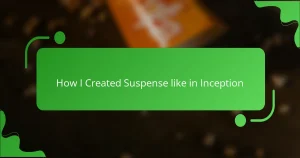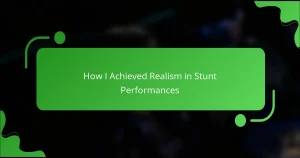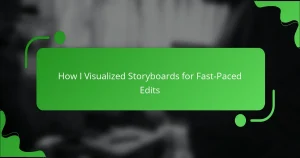Key takeaways
- Action short films focus on intense storytelling within a limited runtime, allowing for creative expression without large budgets.
- Pacing, choreography, and emotional stakes are essential for crafting compelling action scenes that resonate with viewers.
- Car chase scenes serve as pivotal moments that enhance tension and character development, effectively conveying narrative without dialogue.
- Effective storyboarding and dynamic camera work are crucial for creating visually engaging chases that maintain audience adrenaline and excitement.
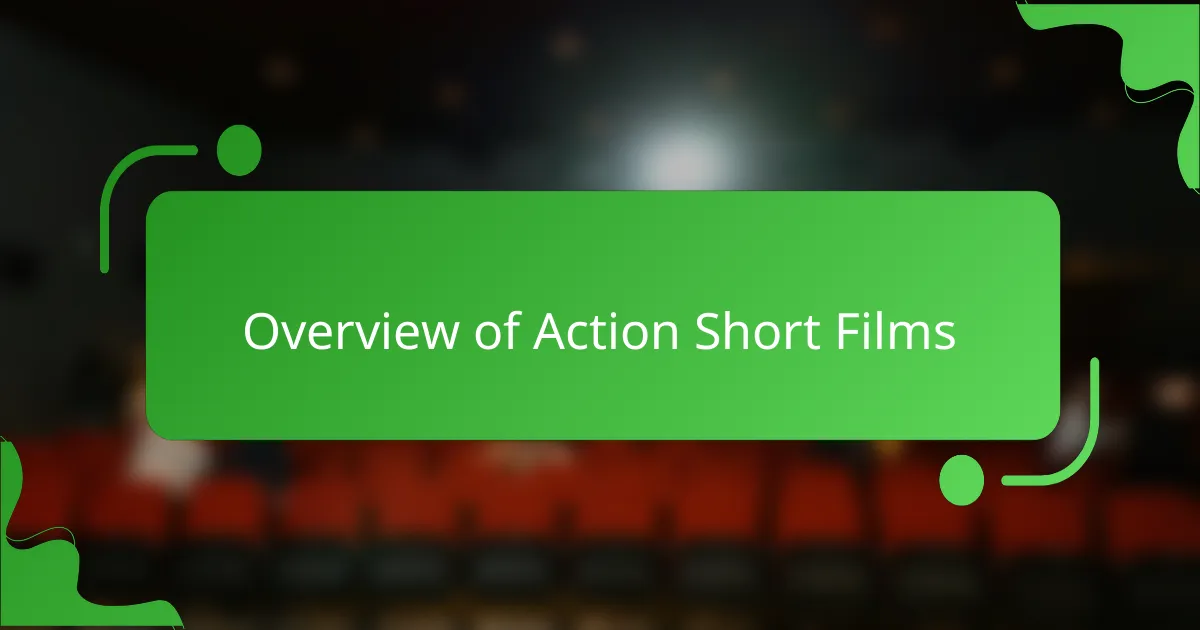
Overview of Action Short Films
Action short films embody the thrill of high-stakes scenarios, often packing intense sequences into just a few minutes. In my experience, these films allow filmmakers to explore creative storytelling without the need for extensive budgets. The adrenaline rush from a well-executed car chase can captivate audiences, showcasing not only technical skill but also the raw emotion of the characters involved.
I remember working on one of my own short films where we had to convey urgency and fear in every scene. The limited timeframe pushed me to think creatively about pacing and visuals, ensuring the viewers felt the tension. It’s a unique challenge that action short films present, and it’s exhilarating to see an idea come to life.
Here’s a comparison of action short films versus full-length features in terms of different aspects:
| Aspect | Action Short Films | Full-Length Features |
|---|---|---|
| Runtime | 5-30 minutes | 90-180 minutes |
| Budget | Usually low | Higher production costs |
| Story Depth | Focused and concise | In-depth character development |
| Action Sequence | High intensity in short bursts | Extended action scenes |
| Audience Engagement | Immediate thrill | Long-term connection |

Key Elements of Action Scenes
Creating compelling action scenes hinges on a few key elements. First, pacing is crucial; it dictates the rhythm of the sequence. I’ve often found that a rapid-fire editing style can inject urgency, making the viewer feel breathless. Remember that split-second cuts? They can heighten tension and enhance the feeling of chaos necessary in a car chase.
Another vital aspect is the choreography of movement. I vividly recall a project where we meticulously planned each turn and brave maneuver. By designing the chase to interweave with the environment—like close encounters with pedestrians or narrow alleys—we transformed what could have been a standard sequence into an exhilarating ride. Did those near-misses make your heart race as much as they did mine?
The emotional stakes should never be overlooked either. In my experience, audiences connect deeply when they can feel the protagonist’s desperation or fear. We made sure every stunt felt personal, reflecting the characters’ stakes in the chase. I often ask myself, how can we make viewers not just watch, but feel every twist and turn? That’s the magic of a well-executed action scene.
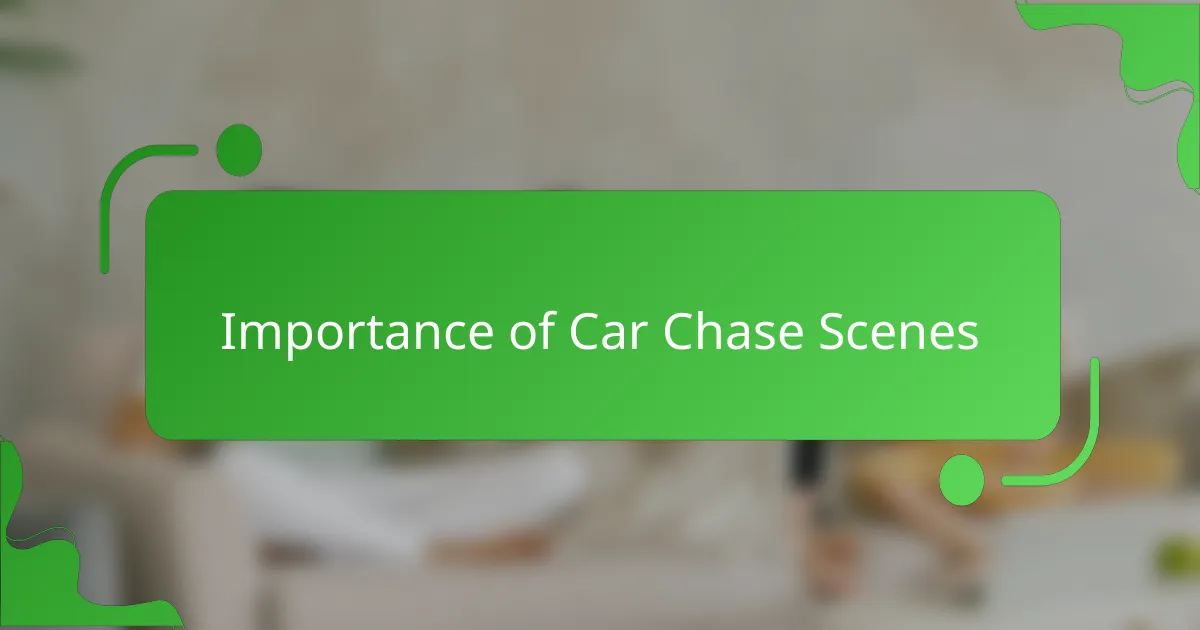
Importance of Car Chase Scenes
Car chase scenes hold a vital place in action short films, often acting as the pivotal moment that heightens tension and propels the narrative forward. I remember one particular chase I crafted, where the thrill surged from every drift and near-miss. The adrenaline was palpable, not just for the characters, but for the audience watching, creating that exhilarating connection that keeps viewers glued to their screens.
What really stands out to me is how car chases can serve as a canvas for character development. They aren’t just about speed; they reflect the stakes at play. Take one of my projects, for instance: the protagonist was racing against time to save a loved one. Each close call with opposing traffic conveyed not just urgency but the emotional weight of the mission, merging action with deep storytelling. Isn’t it incredible how a single chase can resonate so strongly when executed with intention?
Moreover, these scenes are a masterclass in visual storytelling. I’ve learned that a well-crafted car chase can replace pages of dialogue, expressing conflict and emotion without a single word. The roar of engines and the screams of tires on asphalt can tell stories that dialogue sometimes can’t. Have you ever felt your heart race in sync with the cars on screen? That’s the magic of a well-designed chase—when the visuals speak volumes and the story unfolds at breakneck speed.

Techniques for Planning Chases
Planning a car chase scene is an exhilarating puzzle that requires careful thought. I’ve found that scouting locations can make a huge difference; finding unique landscapes and obstacles sets the stage for creativity. During one project, we filmed in an industrial area with tight corners and unexpected jumps, which added an extra layer of thrill and visual interest.
Another technique I swear by is storyboarding the action. Sketching out each key moment helps visualize the sequence and refine the flow. In my last film, mapping out the chase frame-by-frame clarified the pacing and ensured that every twist and turn served both the plot and the characters’ emotions. It’s amazing how a well-planned chase can keep viewers on the edge of their seats!
Lastly, timing the stunts is crucial. I remember working with a stunt team, and we spent hours perfecting the sequence of maneuvers. Each action needed to feel organic and impactful, so we practiced until every drift and pivot felt effortless. What’s your take on how the choreography influences audience perception? In my experience, when stunts are expertly executed, they not only thrill the audience but also elevate the entire film, connecting them emotionally to the events on screen.

Storyboarding Your Chase Scene
Storyboarding a car chase scene is a crucial step in visualizing the action and flow of the sequence. I remember when I storyboarded my first chase; I felt both excitement and anxiety as I tried to capture the dynamic movement and tension. Each frame served as a guide, helping me ensure that every twist and turn complemented the narrative, which is essential for keeping viewers at the edge of their seats.
As I laid out the storyboard, I carefully considered the pacing and angles. A variety of shots—from close-ups that show the characters’ emotional stakes to wide shots that highlight the chase’s scale—helped build intensity. Here’s how I approached the storyboarding process:
- Identify Key Moments: Pinpoint the critical beats of the chase; these are the moments that will drive the excitement.
- Sketch Rough Frames: Don’t worry about artistic perfection; rough sketches can effectively convey action and movement.
- Consider Camera Angles: Vary your perspectives to create dynamic visuals; use low angles for power and high angles for vulnerability.
- Plan Transitions: Think about how each shot flows into the next; smooth transitions maintain the viewer’s adrenaline.
- Incorporate Emotion: Highlight the characters’ reactions to heighten the stakes; their fear or determination can make a chase feel more relatable.

Filming Tips for Car Chases
When filming a car chase, one of my go-to tips is to embrace dynamic camera work. Using techniques like handheld shots or camera mounts on the vehicles can create an immersive experience. I vividly remember a scene we shot where a mounted camera captured every hairpin turn, making viewers feel as if they were right there in the driver’s seat. This creates a visceral connection that static shots just can’t replicate.
Another essential aspect is to consider sound design. The impact of roaring engines and screeching tires can elevate the tension significantly. In my experience, we carefully layered sound effects during post-production to ensure they punctuated key moments in the chase. Have you ever noticed how certain sounds can evoke a rush of adrenaline? It’s fascinating how sound enhances the visual drama and pulls the audience deeper into the action.
Finally, don’t underestimate the power of safety measures. While thrilling stunts are exciting, ensuring the safety of everyone involved is paramount. I’ve been part of productions where we spent considerable time rehearsing stunts to minimize risks. It’s a delicate balance between excitement and safety—after all, achieving that heart-racing thrill should never come at the cost of someone’s well-being. How do you approach safety in your own projects? It’s a question worth pondering every time you plan a high-octane chase.
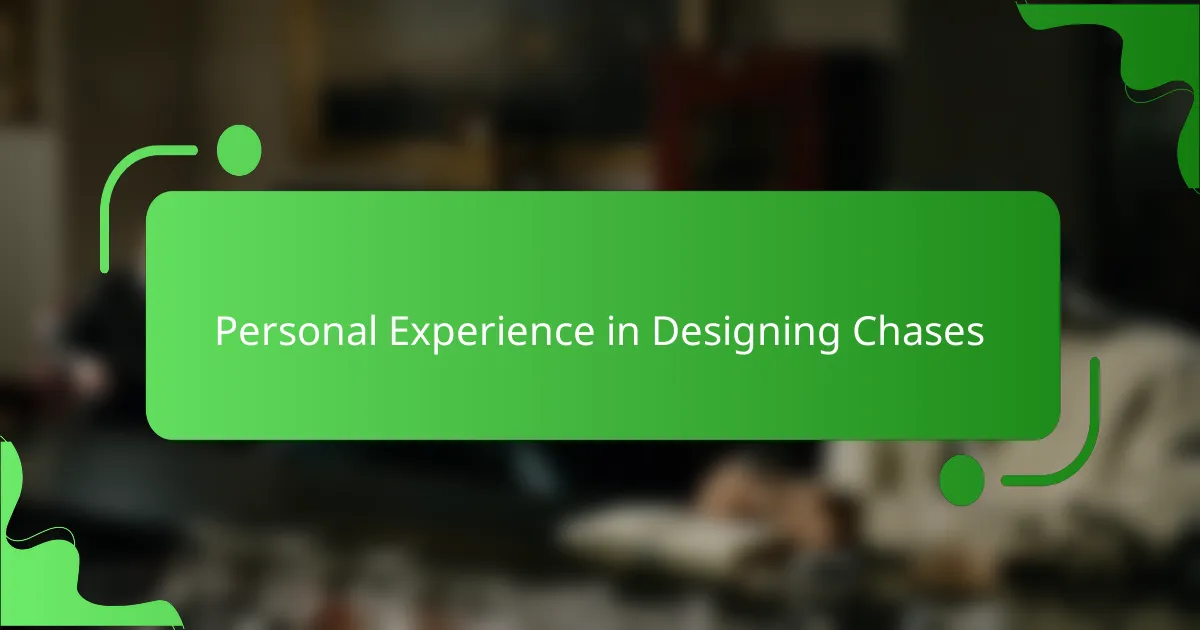
Personal Experience in Designing Chases
When I set out to design a car chase scene, I leaned heavily on my favorite action films for inspiration. I remember one particular late night when I was jotting down ideas and began to visualize the adrenaline-pumping moments that make chase scenes unforgettable. The rush I felt while crafting those rapid turns and near-miss scenarios was exhilarating, reminding me why I love making action short films.
In my experience, timing plays a crucial role in building tension and excitement. During one shoot, we had to nail a particularly challenging sequence. I felt a mix of pressure and excitement as the actors navigated the tight streets, and the thrill of capturing those perfect shots made it all worthwhile. Reflecting on that moment, I realized how essential it is to blend creativity with precise choreography to create an unforgettable chase.
| Aspect | Personal Experience |
|---|---|
| Inspiration Sources | Watching classic action films |
| Tension Building | Timing and choreography are key |
| Emotional Connection | Adrenaline rush during shoots |
